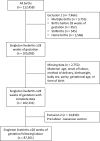Birth "Out-of-Hours": An Evaluation of Obstetric Practice and Outcome According to the Presence of Senior Obstetricians on the Labour Ward
- PMID: 27093698
- PMCID: PMC4836717
- DOI: 10.1371/journal.pmed.1002000
Birth "Out-of-Hours": An Evaluation of Obstetric Practice and Outcome According to the Presence of Senior Obstetricians on the Labour Ward
Abstract
Background: Concerns have been raised that a lack of senior obstetricians ("consultants") on the labour ward outside normal hours may lead to worse outcomes among babies born during periods of reduced cover.
Methods and findings: We carried out a multicentre cohort study using data from 19 obstetric units in the United Kingdom between 1 April 2012 and 31 March 2013 to examine whether rates of obstetric intervention and outcome change "out-of-hours," i.e., when consultants are not providing dedicated, on-site labour ward cover. At the 19 hospitals, obstetric rotas ranged from 51 to 106 h of on-site labour ward cover per week. There were 87,501 singleton live births during the year, and 55.8% occurred out-of-hours. Women who delivered out-of-hours had slightly lower rates of intrapartum caesarean section (CS) (12.7% versus 13.4%, adjusted odds ratio [OR] 0.94; 95% confidence interval [CI] 0.90 to 0.98) and instrumental delivery (15.6% versus 17.0%, adj. OR 0.92; 95% CI 0.89 to 0.96) than women who delivered at times of on-site labour ward cover. There was some evidence that the severe perineal tear rate was reduced in out-of-hours vaginal deliveries (3.3% versus 3.6%, adj. OR 0.92; 95% CI 0.85 to 1.00). There was no evidence of a statistically significant difference between out-of-hours and "in-hours" deliveries in the rate of babies with a low Apgar score at 5 min (1.33% versus 1.25%, adjusted OR 1.07; 95% CI 0.95 to 1.21) or low cord pH (0.94% versus 0.82%; adjusted OR 1.12; 95% CI 0.96 to 1.31). Key study limitations include the potential for bias by indication, the reliance upon an organisational measure of consultant presence, and a non-random sample of maternity units.
Conclusions: There was no difference in the rate of maternal and neonatal morbidity according to the presence of consultants on the labour ward, with the possible exception of a reduced rate of severe perineal tears in out-of-hours vaginal deliveries. Fewer women had operative deliveries out-of-hours. Taken together, the available evidence provides some reassurance that the current organisation of maternity care in the UK allows for good planning and risk management. However there is a need for more robust evidence on the quality of care afforded by different models of labour ward staffing.
Conflict of interest statement
We have read the journal's policy and the authors of this manuscript have the following competing interests: GCS is a member of the Editorial Board of
Figures
Comment in
-
Is There Evidence of Poorer Birth Outcomes for Mothers and Babies When the Most Senior Obstetrician Is Not On Site?PLoS Med. 2016 Apr 19;13(4):e1002001. doi: 10.1371/journal.pmed.1002001. eCollection 2016 Apr. PLoS Med. 2016. PMID: 27092547 Free PMC article.
-
Lack of consultant obstetrician is not associated with worse outcomes in babies, UK study shows.BMJ. 2016 Apr 19;353:i2242. doi: 10.1136/bmj.i2242. BMJ. 2016. PMID: 27099227 No abstract available.
Similar articles
-
Labour outcomes in caseload midwifery and standard care: a register-based cohort study.BMC Pregnancy Childbirth. 2018 Dec 6;18(1):481. doi: 10.1186/s12884-018-2090-9. BMC Pregnancy Childbirth. 2018. PMID: 30522453 Free PMC article.
-
Outcomes of operative vaginal delivery managed by residents under supervision and attending obstetricians: a prospective cross-sectional study.Am J Obstet Gynecol. 2019 Jul;221(1):59.e1-59.e15. doi: 10.1016/j.ajog.2019.02.044. Epub 2019 Feb 23. Am J Obstet Gynecol. 2019. PMID: 30807764
-
Cohort study of operative delivery in the second stage of labour and standard of obstetric care.BJOG. 2003 Jun;110(6):610-5. BJOG. 2003. PMID: 12798481
-
The Birthplace in England national prospective cohort study: further analyses to enhance policy and service delivery decision-making for planned place of birth.Southampton (UK): NIHR Journals Library; 2015 Aug. Southampton (UK): NIHR Journals Library; 2015 Aug. PMID: 26334076 Free Books & Documents. Review.
-
"Strategies to increase the accuracy and safety of OVD" (Clinical assessment skills and role of ultrasound, simulation training and new technologies to enhance instrument application).Best Pract Res Clin Obstet Gynaecol. 2019 Apr;56:35-46. doi: 10.1016/j.bpobgyn.2019.01.015. Epub 2019 Feb 15. Best Pract Res Clin Obstet Gynaecol. 2019. PMID: 30910445 Review.
Cited by
-
Comparison of Caesarean sections and instrumental deliveries at full cervical dilatation: a retrospective review.Singapore Med J. 2019 Feb;60(2):75-79. doi: 10.11622/smedj.2018040. Epub 2018 Apr 19. Singapore Med J. 2019. PMID: 29670996 Free PMC article.
-
An international assessment of trainee experience, confidence, and comfort in operative vaginal delivery.Ir J Med Sci. 2017 Aug;186(3):715-721. doi: 10.1007/s11845-017-1593-0. Epub 2017 Mar 7. Ir J Med Sci. 2017. PMID: 28271279
-
Influence of time of birth in early neonatal mortality and morbidity: retrospective cohort study.BMJ Paediatr Open. 2025 Mar 6;9(1):e003236. doi: 10.1136/bmjpo-2024-003236. BMJ Paediatr Open. 2025. PMID: 40050027 Free PMC article.
-
Office hours and caesarean section: systematic review and Meta-analysis.Res Health Serv Reg. 2022 Jun 22;1(1):4. doi: 10.1007/s43999-022-00002-6. Res Health Serv Reg. 2022. PMID: 39177807 Free PMC article. Review.
-
Can the Day of the Week and the Time of Birth Predict the Mode of Delivery According to Robson Classification?Healthcare (Basel). 2023 Jul 28;11(15):2158. doi: 10.3390/healthcare11152158. Healthcare (Basel). 2023. PMID: 37570398 Free PMC article.
References
-
- Watt N Cameron vows to transform NHS into world's first seven-day health service. The Guardian. http://www.theguardian.com/politics/2015/may/18/cameron-seven-day-health...
Publication types
MeSH terms
LinkOut - more resources
Full Text Sources
Other Literature Sources
Medical
Miscellaneous



